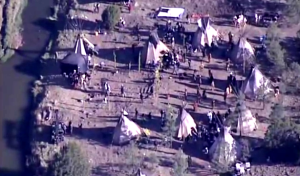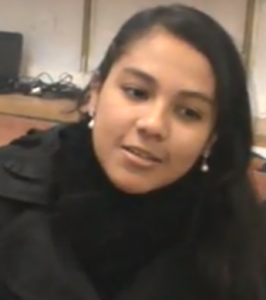Senator McCain gets punked by a righteous #indigenous youth! #SaveOakFlat #SaveSacredSites
Adriano Tsinigine Dine Navajo Youth serves papers to Senator McCain August 14, 2015 Navajo youth Adriano Tsinigine served papers to Senator John McCain to #SaveOakFlat! August 14, 2015Original photo at https://www.facebook.com/photo.php?fbid=1597159437211246 In a heroic demonstration of bravery and resistance Navajo student Adriano Tsinigine approached Senator John McCain during a visit to the Navajo Nation capital of Window Rock August 14, 2015, and asked to have his picture taken with the politician. Photo ops were part of the day honoring the Navajo Code Talkers, as were protests which made news for chasing McCain off the Navajo Nation – quite an historic day for the Navajo! Tsinigine’s special handshake for Oak Flat was caught on video and also went viral. Here’s the young man’s account on facebook of what happened, from his photo share on the wall of the facebook page Apache Stronghold: Adriano Tsinigine > Apache Stronghold Showing my support from the Navajo Nation. Met Mr. McCain, and asked for a photo, then I pulled out my ‘Protect Oak Flat’ card and when he seen it, he looked me right in the eye and said “Get out of here, now!” Haha, this ma’ii is just afraid of us, because of how powerful we are… I personally met Tsinigine last month in Washington DC where I was livestreaming and photo-documenting the Apache Stronghold rally in support of the Save Oak Flat Act on the US Capitol July 22, 2015 (scroll to the bottom of this page for links). After a long eventful day, I accompanied a group of mostly Apache women from Apache Stronghold in Union Station as we sat to regroup and order some food. Tsinigine was in DC with a delegation of Navajo students and approached the Apaches to introduce himself and express his solidarity. I left shortly after to find myself some cooked kosher food. Why protest McCain about protecting a sacred Apache ceremonial ground still in use? McCain created this whole mess by tacking an amendment on to the National Defense Authorization Act at the eleventh hour which passed in December 2014, to give the region of protected federal wilderness to Rio Tinto, an international mining company, following years of Congress’ repeated rejections. McCain has a history of circumventing or establishing laws to enable theft and development of indigenous lands. I wrote an article for the Navajo Times in 2008 about Navajo people in northeast Arizona who resisted relocation while McCain led the Senate Committee on Indian Affairs and were now opposing McCain in that year’s presidential election. The locals in the Hardrock Chapter have compared McCain to Colonel Kit Carson. For decades, McCain has been behind legislation that forcibly removed traditional Navajo people from their ancestral sacred lands and constrained residential maintenance and repairs on homes in an even broader region to make way for coal extraction and other developments. The Apache war with Senator McCain is not new, nor is McCain’s disdain for democracy. In southeast Arizona, the San Carlos Apache have been fighting against the desecration of Mount Graham, Dzil Nchaa Si’ An, for decades. An international alliance including The Vatican, the University of Arizona, and other partners built the Mount Graham International Observatory beginning in the 1980’s with an exemption from the Endangered Species Act because McCain crafted riders to federal laws that would amend them to permit the militarized and astronomical development on protected public lands that are also indigenous sacred sites. A Men’s Journal 2008 article revisits this process that McCain spearheaded to remove the impact of federal law on developments and land acquisition. David Hodges, policy director of the Tucson-based Sky Island Alliance, recalled McCain working behind the scenes in 1988 to craft a rider that exempted the construction of the “Pope Scope” from the Endangered Species Act on the sacred Apache mountain. McCain’s model was applied across the entire southwest border region in seizing private, public and indigenous lands to construct the US-Mexico border wall exempt from environmental law, thousands of miles of which are traditional Apache territory. McCain’s creepy cooperation with The Vatican in paving the way for the international observatory on Mount Graham is a nauseating echo from the centuries of brutal colonization by the Catholic Church across the indigenous southwest and the centuries before that of governmental alliances with the church and higher education institutions in imposing the deathly Inquisition on Europe’s women, Jews, and other so-called heretics. We are witness to these same establishments continuing their pursuit of power and oppression to this day. This all is taking place the same week that the Jewish performing artist Matisyahu was uninvited from [and later reinvited to] a festival in Spain for his political positions – and no other artists were given the litmus test. Where I live, the indigenous peoples of California are currently protesting Pope Frances’ intention to canonize Junipero Serra, the friar who built the mission system in California and terrorized much of the natives peoples of the region, as I reported in my most recent Jewcology blog entry. Which is why this image of Adriano Tsinigine is so powerful! I love seeing this photo of a bright-eyed, clear-minded young man applying his wit, smarts and convictions in strength and grace to this opportune moment to stick it to McCain the devilish politician who has legacies behind him of conniving against the indigenous and the American people. Toda reba Adriano! Ahéhee’! Thank you! ### Apache Convoy to DC: Washington DC 7/22/15 Documentation from Wendy Kenin @greendoula Facebook Event: https://www.facebook.com/events/498012587042267/ Rally At the US Capitol in support of the Save Oak Flat Act Recorded Livestreams Part 1 http://www.ustream.tv/recorded/68360721 or https://youtu.be/YQipDAjEeCc Part 2 http://www.ustream.tv/recorded/68364537 or https://youtu.be/sYWvHg5-xLc Part 3 http://www.ustream.tv/recorded/68365983 or https://youtu.be/sHISiMN3pD0 Excerpt of Apache Stronghold Convoy To DC member intros http://www.ustream.tv/recorded/68365615 or https://youtu.be/MkT3v286MjU Attempt to Lobby – Confrontation at Rep Gosar’s Office http://www.ustream.tv/recorded/68385413 or https://youtu.be/StA2k3eqBDs Interviews with Apache Women about Oak Flat http://www.ustream.tv/recorded/68388644 or https://youtu.be/3db9QNqaBrA Anyone can create a highlight from the ustream videos. Otherwise, youtube is the preferred place to watch. #SAVEOAKFLAT: Carol Haozous of San Carlos Apache Tribe Interview http://www.ustream.tv/recorded/68388644/highlight/642989 Wounded Knee Deocampo of CA in support of #SaveOakFlat #ApacheStronghold Rally at US Capitol http://www.ustream.tv/recorded/68360721/highlight/643171 Photos Facebook “best of” photo set: https://www.facebook.com/greendoula/media_set?set=a.10152922125830863.1073741840.721895862 Flickr full album link: https://www.flickr.com/photos/greendoula/sets/72157653948034223




